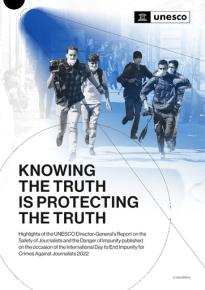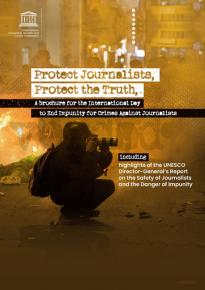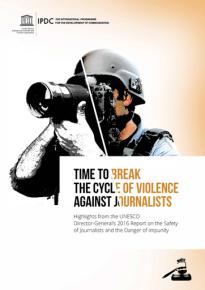
Director-General's Report on the Safety of Journalists and the Danger of Impunity
The UNESCO Director General’s Report responds to a call from the 39 Member States in UNESCO’s International Programme for the Development of Communication (IPDC) to provide an analytical report on the killing of journalists, media workers and social media producers engaged in journalistic activities.
The Report is a unique mechanism within the UN system for monitoring the killings of journalists.
The Report is published every two years, coinciding with the commemoration of the International Day to End Impunity for Crimes against Journalists and presented at the IPDC’s Intergovernmental Council Session. The Session is an occasion for Member States to take stock of global developments and discuss challenges linked to promoting the safety of journalists and combatting impunity.

Previous Statutory Reports




IPDC Intergovernmental Council Decisions
- IPDC Decision on the Safety of Journalists and the Issue of Impunity (2008)
- IPDC Decision on the Safety of Journalists and the Issue of Impunity (2010)
- IPDC Decision on the Safety of Journalists and the Issue of Impunity (2012)
- IPDC Decision on the Safety of Journalists and the Issue of Impunity (2014)
- IPDC Decision on the Safety of Journalists and the Issue of Impunity (2016)
- IPDC Decision on the Safety of Journalists and the Issue of Impunity (2018)
- IPDC Decision on the Safety of Journalists and the Issue of Impunity (2020)
- IPDC Decision on the Safety of Journalists and the Issue of Impunity (2022)

Background to the Report
The Report was first published in 2008 upon a Decision of the Intergovernmental Council of the IPDC. The Decision requested the Director-General of UNESCO to produce a document which includes the responses received from concerned Member States on the status of judicial inquiries into the killings.
It began in 2008 as a brief analytical summary of journalist killings, and since then it has become a comprehensive repository on everything to do with the monitoring of journalist safety.
In 2022, for the first time, the IPDC’s Intergovernmental Council recommended that the Report provide “more information on non-lethal attacks against journalists in line with the synergies of the Universal Periodic Review methodology and the reporting on SDG 16.10.1”.
Facts & Figures


A Tool for Global Advocacy
The UNESCO Director-General’s Report on the Safety of Journalists and the Danger of Impunity is a core international instrument for the monitoring of journalist killings and the monitoring of global and regional impunity for crimes committed against journalists.
The UN Statistical Commission recognises the Report as a key data source contributing towards SDG 16.10 to “ensure public access to information and protect fundamental freedoms, in accordance with national legislation and international agreements”.
Since 2006 UNESCO has been systematically monitoring crimes against journalists. Since then the Report has formally consolidated UNESCO’s findings which give a global assessment of the most recent two-year period. It provides in-depth analysis on journalist killings, an analysis of Member State responses on ongoing or unresolved cases, and detailed accounts of regional and international legislative and monitoring developments.
The Report provides disaggregated and verified data on crimes against journalists for use by civil society organisations, international organisations, researchers, journalists, judicial actors, students and the wider public interested in the safety of journalists. This data is available on UNESCO's Observatory of Killed Journalists.
Our Methodology for Recording Killings of Journalists
The term journalist in UNESCO's monitoring and reporting mechanisms covers “journalists, media workers and social media producers who are engaged in journalistic activity”, in line with IPDC Decisions on the Safety of Journalists and the Issue of Impunity adopted by the IPDC Council in 2008, 2010, 2012, 2014, 2016, 2018, 2020 and 2022. This definition also aligns with General Comment No. 34's broad interpretation of journalism as a "shared function" by a wide range of actors, including professional full-time reporters and analysts, as well as bloggers and others who engage in forms of self-publication in print, on the internet."
The cases of journalist killings recorded in this Observatory are also identified and verified based on confirmatory reports from multiple sources, including international, regional and local monitoring groups; UNESCO field offices; UNESCO Permanent Delegations; and other UN bodies and mechanisms such as Special Rapporteurs. In addition, for a case to be verified, a journalist must have been targeted for reprisals as a result of their work, or killed while on assignment.
Status of Investigations
The information in this Report on the status of the investigations carried out on each killing condemned by the Director-General is based solely on the updates provided by concerned States.
The cases of killings of journalists are systematically condemned by the Director-General of UNESCO through press releases. General Conference 29 C/Resolution 29 (1997) mandates the Director-General to “condemn assassination and any physical violence against journalists as a crime against society, since this curtails freedom of expression and, as a consequence, the other rights and freedoms set forth in international human rights instruments”. This mandate has been reinforced by other resolutions, such as the General Conference 36 C/Resolution 53 (2011), which calls on UNESCO to monitor the status of press freedom and safety of journalists in coordination with other UN bodies and relevant organizations in this field.
The information provided by States has been analyzed for the purpose of this study and categorized as follows:
Resolved
The status of a case regarding the killing of a journalist is considered as “Resolved” if the State has provided one or more of the following responses to the Director-General’s request to provide information concerning the status of the investigation:
The perpetrator(s) of the crime has (/have) been brought to justice and been convicted by a court of law.
The suspected perpetrator(s) of the crime died before a court case could take place or be completed.
The judicial process has revealed that the death was not related to the victim’s journalistic practice.
The perpetrator(s) of the crime has (/have) been determined and sentenced, but due to a Presidential Pardon or Amnesty Law, they are released before their sentence has been carried out fully.
The Director-General no longer requests status updates once a case is deemed to have been resolved. However, a case may be moved back to the “Ongoing/Unresolved” category if UNESCO is informed of new developments about the case, such as an appeal, occurring at national, regional or international courts. In these cases, UNESCO will resume requesting status updates from the concerned State.
Ongoing/Unresolved
The status of a case regarding the killing of a journalist is considered as “Ongoing/Unresolved” if the State has provided one of the following responses to the Director-General’s request to provide information concerning the status of the investigation:
The case is currently being investigated by law enforcement agencies or other relevant authorities.
The case has been taken up by the judicial system but a final verdict has not yet been reached and the suspect(s) has (/have) not been convicted and sentenced. The “Ongoing/Unresolved” category also applies to cases where an appeal is ongoing or where only one of the suspected killers has been convicted and sentenced.
The journalist has been reported by the Member State as having been killed by foreign actors beyond national jurisdiction.
A court of law has acquitted the suspected perpetrator(s) of the crime (for example due to lack of or tampered evidence).
A court of law has ruled to archive the case or is otherwise unable to be processed through the judiciary system (for example, due to statutes of limitations). This category therefore also includes those cases for which a judicial process has been completed, but where no person(s) has (/have) yet been successfully held accountable in terms of due legal process, and hence where impunity in regard to the killing(s) still remains unresolved.
The Director-General continues to request status updates for all of the above cases, except in the instances where it is explicitly mentioned that the case has been judicially archived or killed by foreign actors beyond national jurisdiction.
No information received so far
“No information received so far” is used if the State has never provided information to UNESCO on the status of the investigation, whether this year or in previous years. This does not, however, exclude the possibility of the case having been resolved unbeknownst to UNESCO.
‘Acknowledgments’ are included in this category insofar as they do not include any specific information on the judicial follow-up into the cases of killings of journalists condemned by the Director-General.
The Director-General continues to request status updates for such cases.
Categorization of State Reactions
When a State sends concrete information regarding the judicial process following the killing of a journalist, this is considered a response to the Director-General’s request.
When a State acknowledges the receipt of the request (either by letter or by e-mail) and indicates further action, but does not deliver concrete information regarding specific cases, this is considered an acknowledgement.
Both responses and acknowledgements constitute reactions to the Director-General's request.
All concerned States are requested to authorize the publication of their responses which can be accessed here.
This graph shows the rate of State reactions to the Director-General's requests for information on the judicial status of cases of journalist killings in % from 2013 to 2022.







